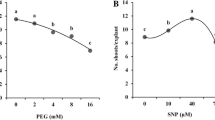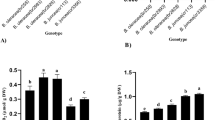Abstract
In this study, different levels of polyethylene glycol (PEG) 6000 (5, 7.5 and 10% w/v) were applied to induce drought stress in the embryo and callus culture of Salvia leriifolia Benth, an Iranian medicinal plant. The results related to the embryo culture showed that the germination percentage, stem length, root and stem diameter and total chlorophyll content of plantlets decreased by increasing the PEG concentration, while the highest root length was obtained at the lower PEG concentration (5%). The short-term callus culturing on the media containing different concentrations of PEG resulted in an insignificant difference in the fresh weight, dry weight, and browning intensity of calli between the PEG-free and 5% PEG medium. The proline, hydrogen peroxide, and malondialdehyde contents as indicators of oxidative stress significantly increased in the plantlets and calli at all PEG concentrations. The activity of antioxidant enzymes including catalase and guaiacol peroxidase also increased while superoxide dismutase activity decreased. The rosmarinic acid, caffeic acid, and salvianolic acid B contents increased significantly in all the plantlets and calli culture media containing the PEG. However, the highest contents of these secondary metabolites in plantlets and callus cultures were observed in the medium with 5% PEG. Totally, the results showed that, the short-term reduction in the osmotic potential of culture medium by low concentration of PEG elicitor can effectively improve the content of rosmarinic acid, caffeic acid, and salvianolic acid B in S. leriifolia, especially in callus cultures.
Key message
Polyethylene glycol elicitor as a drought stress inducer can be effectively improved the content of rosmarinic acid, caffeic acid, and salvianolic acid B in plantlet and callus culture of Salvia leriifolia benth.








Similar content being viewed by others
Abbreviations
- CAT:
-
Catalase
- DW:
-
Dry weight
- FW:
-
Fresh weight
- GPX:
-
Guaiacol peroxidase
- H2O2 :
-
Hydrogen peroxide
- HPLC:
-
High-performance liquid chromatography
- MDA:
-
Malondialdehyde
- PEG:
-
Polyethylene glycol
- PPO:
-
Polyphenol oxidase
- ROS:
-
Reactive oxygen species
- SOD:
-
Superoxide dismutase
Refrences
Aebi H (1984) Catalase in vitro. Methods Enzymol 105:121–126
Alexieva V, Sergiev I, Mapelli S, Karanov E (2001) The effect of drought and ultraviolet radiation on growth and stress markers in pea and wheat. Plant Cell Environ 24:1337–1344
Başkan S, Öztekin N, Erim FB (2007) Determination of carnosic acid and rosmarinic acid in sage by capillary electrophoresis. Food Chem 101:1748–1752
Bates L, Waldren RP, Teare ID (1973) Rapid determination of free proline for water stress studies. Plant Soil 39:205–207
Bradford MM (1976) Rapid and sensitive method for the quantitation of microgram quantities of protein utilizing the principle of protein-dye binding. Anal Biochem 72:248–254
Dong J, Wan G, Liang Z (2010) Accumulation of salicylic acid-induced phenolic compounds and raised activities of secondary metabolic and anti-oxidative enzymes in Salvia miltiorrhiza cell culture. J Biotechnol 148:99–104
Efferth T (2019) Research traditional biotechnology applications of plant callus cultures. Chin Med 5:50–59
Farooq M, Wahid A, Kobayashi N, Fujita D, Basra SMA (2009) Plant drought stress: effects, mechanisms and management. Agron Sustain Dev 29:185–212
Gamaro GD, Suyenaga E, Borsoi M, Lermen J, Pereira P, Ardenghi P (2011) Effect of rosmarinic and caffeic acids on inflammatory and nociception process in rats. ISRN Pharmacol 10:1–6
Ghasimi Hagh Z, Jokar S, Bodaghi H, Modarres M (2018) Effect of salicylic acid and methyl jasmonate on the production of rosmarinic acid and caffeic acid in callus culture of Salvia lerrifolia Benth. Iran J Plant Biol 10(1):67–80
Ghassemi-Golezani K, Farhadi N, Nikpour-Rashidabad N (2018) Responses of in vitro-cultured Allium hirtifolium to exogenous sodium nitroprusside under PEG-imposed drought stress. Plant Cell Tissue Org 133:237–248
Giannopolitis CN, Ries SK (1977) Superoxide dismutases: I. Occurrence in higher plants. Plant Physiol 59:309–314
Hamrouni-Sellami I, Rahali FZ, Rebey IB, Bourgou S, Limam F, Marzouk B (2013) Total phenolics, flavonoids and antioxidant activity of sage (Salvia officinalis L.) plants as affected by different drying methods. Food Bioprocess Technol 6:806–817
Heath RL, Packer L (1968) Photoperoxidation in isolated chloroplasts. I. Kinetics and stoichiometry of fatty acid peroxidation. Arch Biochem Biophys 125:180–198
Hellal FA, El-Shabrawi HM, El-Hady MA, Khatab IA, El-Sayed SAA, Abdelly C (2018) Influence of PEG induced drought stress on molecular and biochemical constituents and seedling growth of Egyptian barley cultivars. J Genet Eng Biotechnol 16:203–212
Hosseinzadeh H, Lary P (2000) The effect of Salvia leriifolia Benth root extracts on morphine dependence in mice. Phytother Res 14:384–387
Hosseinzadeh H, Yavary M (1999) Anti-inflammatory effect of Salvia leriifolia Benth. leaf extract in mice and rats. Harm Pharmacol Lett 9:60–62
Hosseinzadeh H, Haddad Khodaparast MH, Hosseini E (2000) Anti-ulcer effect of Salvia leriifolia Benth. leaf extract in mice. Pharm Pharmacol Lett 10:63–64
Jaleel CA, Manivannan P, Sankar B, Kishorekumar A, Gopi R, Somasundaram R, Panneerselvam R (2007) Induction of drought stress tolerance by ketoconazole in Catharanthus roseus is mediated by enhanced antioxidant potentials and secondary metabolite accumulation. Colloids Surf B 60:201–206
Jamal Omidi F, Mohajjel Shoja H, Sariri R (2018) Effect of water deficit stress on secondary metabolites of Melissa officinalis L.: role of exogenous salicylic acid. Casp J Environ Sci 16:121–134
Jatoi SA, Latif MM, Arif M, Ahson M, Khan A, Siddiqui SU (2014) Comparative assessment of wheat landraces against polyethylene glycol simulated drought stress. Sci Tech Dev 33:1–6
Kamatou GPP, Makunga NP, Ramogola WPN, Viljoen AM (2008) South African Salvia species: a review of biological activities and phytochemistry. J Ethnopharmacol 119:664–672
Khosroushahi AY, Naderi-Manesh H, Simonsen HT (2011) Effect of antioxidants and carbohydrates in callus cultures of Taxus brevifolia: evaluation of browning, callus growth, total phenolics and paclitaxel production. Bio Impacts 1:37–45
Kim YJ, Shanmugasundaram S, Yun SJ, Park HK, Park MS (2001) A simple method of seedling screening for drought tolerance in soybean. Korean J Crop Sci 46:284–288
Liao WB, Huang GB, Yu JH, Zhang ML (2012) Nitric oxide and hydrogen peroxide alleviate drought stress in marigold explants and promote its adventitious root development. Plant Physiol Biochem 58:6–15
Lima JM, Nath M, Dokku P et al (2015) Physiological, anatomical and transcriptional alterations in a rice mutant leading to enhanced water stress tolerance. AoB Plants 27:7. plv023
Loizzo MR, Menichini F, Tundis R, Bonesi M, Conforti F, Nadjafi F, Menichini F (2009) In vitro biological activity of Salvia leriifolia Benth essential oil relevant to the treatment of Alzheimer’s disease. J Oleo Sci 58:443–446
Lu Y, Foo LY (2002) Polyphenolics of Salvia. Phytochem 59:117–140
Maehly A, Chance B (1954) Catalases and peroxidases. Methods Biochem Anal 1:357–424
Min-Hui L, Jian-Min C, Yong P, Pei-Gen X (2008) Distribution of phenolic acids in Chinese Salvia plants. World Sci Technol 10:46–52
Modarres M, Abrishamchi P, Farhoosh R, Ejtehadi H (2007) Variation of antioxidant activity of Salvia leriifolia Benth. root and leaf extracts during the different stages of plant growth. Iran J Med Aroma Pl 23:285–294
Modarres M, Asili J, Lahouti M, Iranshahi M, Sahebkar A (2014) Simultaneous determination of rosmarinic acid, salvianolic acid B and caffeic acid in Salvia leriifolia Benth. root, leaf and callus extracts using a high-performance liquid chromatography with diode-array detection technique. J Liq Chromatogr Relat Technol 37:1721–1730
Modarres M, Esmaeilzadeh Bahabadi S, Taghavizadeh Yazdi ME (2018) Enhanced production of phenolic acids in cell suspension culture of Salvia leriifolia Benth. using growth regulators and sucrose. Cytotechnology 70:741–750
Murashige T, Skoog F (1962) A revised medium for rapid growth and bio-assays with tobacco tissue cultures. Physiol Plant 15:473–497
Naik PM, Al-Khayri JM (2016) Impact of abiotic elicitors on in vitro production of plant secondary metabolites: a review. J Adv Res Biotech 2:1–7
Nazar R, Umar S, Khan NA, Sareer O (2015) Salicylic acid supplementation improves photosynthesis and growth in mustard through changes in proline accumulation and ethylene formation under drought stress. S Afr J Bot 98:84–94
Petersen M, Simmonds MS (2003) Rosmarinic acid. Phytochem 62:121–125
Pratibha G, Satyawati S, Sanjay S (2015) Biomass yield and steviol glycoside production in callus and suspension culture of Stevia rebaudiana treated with proline and polyethy-lene glycol. Appl Biochem Biotech 176:863–874
Puente-Garza CA, Meza-Miranda C, Ochoa-Martínez D, García-Lara S (2017) Effect of in vitro drought stress on phenolic acids, flavonols, saponins, and antioxidant activity in Agave salmiana. Plant Physiol Biochem 115:400–407
Rechinger KH (1982) Flora Iranica, vol 150. Akademische Druck.u.Verlagsanstalt, Graz
Ren-Wang J, Kit-Man L, Po-Ming H, Thomas CW, Mak KS, Kwok-Pui F (2005) Chemistry and biological activities of caffeic acid derivatives from Salvia miltiorrhiza. Curr Med Chem 12:237–246
Sadeghnia H, Nassiri Asl M, Haddad Khodaparast M, Hosseinzadeh H (2003) The effect of Salvia leriifolia Benth. Root extracts on lipid peroxidation level during global ischemic-reperfusion in rats. J Med Plant 3:19–28
Salma UK, Khatun F, Bhuiyan MJH, Yasmin S, Khan TH (2016) In vitro screening for drought tolerance of some chickpea varieties in Bangladesh. Prog Agr 27:110–118
Sarmadi M, Karimi N, Palazón J, Ghassempour A, Mirjalili MH (2019) Improved effects of polyethylene glycol on the growth, antioxidative enzymes activity and taxanes production in a Taxus baccata L. callus culture. Plant Cell Tissue Org. 137:319–328
Savelev SU, Okello EJ, Perry EK (2004) Butyryl and acetyl-cholinesterase inhibitory activities in essential oils of Salvia species and their constituents. Phytother Res 18:315–324
Shimojo Y, Kosaka K, Noda Y, Shimizu T, Shirasawa T (2010) Effect of rosmarinic acid in motordys function and life span in a mouse model of familial amyotrophic lateral sclerosis. J Neurosci Res 88:896–904
Tátrai ZA, Sanoubar R, Pluhár Z, Mancarella S, Orsini F, Gianquinto G (2016) Morphological and physiological plant responses to drought stress in Thymus citriodorus. Int J Agron 10:1–8
Vaughn KC, Duke SO (1984) Function of polyphenol oxidase in higher plants. Physiol Plant 60:106–112
Wang J, Xiong X, Feng B (2013) Cardio vascular effects of salvianolic acid B. Corporation evidence-based complementary and alternative medicine. Hindawi Publishing, Cairo
Yamaner O, Erdag B (2013) Effects of sucrose and polyethylene glycol on hypericins content in Hypericum adenotrichum. Eurasia J Biosci 7:101–110
Yang D, Huang Z, Xing B, Jin W, Yan X, Guo Z, Liang Z (2016) Regulation of folic acid on phenolic acids production in Salvia miltiorrhiza hairy roots. Plant Cell Tissue Org 127:175–185
Acknowledgements
The author gratefully acknowledge financial support from the Department of Horticulture Science and Plant Protection, College of Agriculture, Shahrood University of Technology, Iran.
Author information
Authors and Affiliations
Contributions
NSH contributed to in vitro cultures establishment, data extraction, and statistical analysis. ZGH conceived and designed research, supervised the whole experiments, statistical analysis, and wrote the manuscript. HK supervised the study and revised the manuscript. All authors read and approved the final manuscript.
Corresponding author
Ethics declarations
Conflict of interest
The authors declare that they have no conflict of interest.
Additional information
Communicated by Silvia Moreno.
Publisher's Note
Springer Nature remains neutral with regard to jurisdictional claims in published maps and institutional affiliations.
Rights and permissions
About this article
Cite this article
Hosseini, N.S., Ghasimi Hagh, Z. & Khoshghalb, H. Morphological, antioxidant enzyme activity and secondary metabolites accumulation in response of polyethylene glycol-induced osmotic stress in embryo-derived plantlets and callus cultures of Salvia leriifolia. Plant Cell Tiss Organ Cult 140, 143–155 (2020). https://doi.org/10.1007/s11240-019-01718-z
Received:
Accepted:
Published:
Issue Date:
DOI: https://doi.org/10.1007/s11240-019-01718-z




